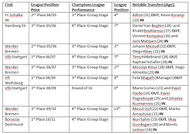TSG Hoffenheim, with an average age of just 23.8, are the youngest side in the Bundesliga and maybe Europe.
Just yesterday, news came through from a press conference held by the DFB, which announced record breaking attendance numbers for the first half of the season. With an average of 44,345 spectators per game, the Bundesliga easily ranks the highest in Europe in attendance numbers.
That statistic has belonged to the Bundesliga for a good few years and with this years increasing numbers in face of stagnant growth within its rival leagues, the Bundesliga’s dominance in ticket sales looks set to continue into the future.
It hasn’t been difficult to figure out just what has brought about this surge in popularity. One of the major reasons was the staging of the 2006 World Cup in Germany. Not only did it rekindle the passion for the sport with in the country, but also the responsibility of hosting World Cup matches lead the German authorities to rebuild many of the popular stadiums.
With the continuous building and renovating of stadiums during the mid 2000′s, the Bundesliga saw their average attendance numbers gradually increase by almost 4000 from 2002/03 to 2003/04 and then again by 4000 in the final year leading up to the World Cup.
By the time the season following the World Cup ended, the average attendance was calculated to be 41000 compared to 33000 in the 2002/03 season.
Another reason for the increase in popularity of the Bundesliga has been the remarkable influx of youngsters into many Bundesliga sides. This influx of youth is one which is completely unique within Europe’s biggest leagues and one which very much separates the Bundesliga from the rest of the well watched leagues.
The increase in youngsters within the squad has been quite gradual from the mid 2000′s, when the Bundesliga was arguably at its trough in terms of overall quality and popularity with viewers outside of Germany. The play was largely dull and made true the popular stigma that German football was robotic and devoid of much exciting attacking play.

History from the 2003/04 season to the current 2011/12 season of average age of Bundesliga sides with a trend line
While the data points from the graph seem to be in pretty close proximity numerically, the linear trend line shows a clear decreasing nature of the average age of Bundesliga sides for the past nine years. From an age of just over 26 in the 2003/04 season to an age of just over 25 in the current season, we can see that, on average, Bundesliga sides are putting more trust in younger players.
It’s a trend that is unique to the Bundesliga in comparison to the other three major leagues in Europe (Spanish La Liga, Italian Seria A, English Premier League).
As seen from the graphs, the average ages of teams from the other three major leagues show amazing consistency throughout the same period as that analyzed for the Bundesliga, thereby proving that the trend within the Bundesliga has been a unique one.
Inability to maintain best players leads to stagnation and decline:
While the Bundesliga has seen a huge rise of interest from the foreign audience, it still clearly lacks the respect it deserves. Still seen as inferior to the other three major leagues, the Bundesliga’s overall quality is always scrutinized when players from within the league are assessed.
Generally also, we are recently witnessing the trend of the Bundesliga becoming a stepping stone for many aspiring youngsters, who wish to shine their lights alongside the biggest names in World Football. Invariably, that only comes from playing in some of the bigger teams in either the Premier League, La Liga or Seria A.
It has become a rarity to see a major name in World Football decide to move onto a Bundesliga club, besides Bayern Munich, who themselves are finding it more and more difficult to attract some of the world’s best players arguably because of the players reluctance to move to the Bundesliga, its a stain on the league rather than the club.
Alex Hleb, Dimitar Berbatov, Timo Hildebrand, Khalid Bouhlarouz, Tomas Rosicky, Diego Ribas, Rafael Van Der Vaart, Nuri Sahin and Arturo Vidal are just some of the players who were stars of the Bundesliga only to see themselves force their clubs hand and sell them to clubs in one of the other three top tier leagues.
What’s important to see that these players were not playing amidst a team struggling with mid-table mediocrity but rather saw themselves as title candidates (it would’ve been foolish to think otherwise considering that we’ve seen five different Bundesliga champions in the last eight years).
Timo Hildebrand left Stuttgart for Valencia, a side who finished fourth in the La Liga, the same year Hildebrand lifted the German club and came runners up in the DFB Pokal; a clear sign of the divide between the two leagues prestige. Though it is important to notice that, even though Hildebrand is German, many German national players rejected the call of from foreign leagues during the mid 2000′s which saw majority of the aforementioned players leave.
Per Mertesacker, Mike Hanke, Torsten Frings, Miroslav Klose, Lukas Podolski and Bastian Schweinsteiger were well demanded outside of Germany but choose to reject those temptations even so that some of them have now eventually moved away. That trend though is now looking weaker with the recent exits of Mesut Ozil, Per Mertesacker and Sami Khedira while Lukas Podolski is also almost certain to leave soon.
Here is a table showing how many Champions League qualifying Bundesliga clubs have done following their successful season:
In analysis of the 21 squads who qualified for the Champions League during the past seven seasons, there are eight clear examples of squads who under performed either in the Champions League or domestic league (both most likely) the following year and we can see that there is at least one transfer involving a superstar exiting and being replaced by a younger player (It should be noted that of the 21 squads that qualified for the Champions League, Bayern Munich squads accounted for 6 of them).
This transfer policy adopted, mostly forcefully, by many of the top Bundesliga clubs has been one of the main reasons for the sharp decline we now see in the Bundesliga in terms of the average age of the squads. It is a profit making policy, it should be stated. Many Bundesliga clubs are satisfied with earning a few million euro’s from the sale of their best players whom they bought for pennies just a few seasons prior.
Alex Hleb was bought for only 150,000 Euro’s only to be sold for 15 Million Euro’s after five seasons, Diego Ribas’ sale garnered an 18.5 Million Euro profit for Werder Bremen in just three seasons while the latest sale of Mesut Ozil racked in a profit of 11 Million Euro’s.
These transfer policies are usually imagined by clubs within the mid-table regions of the other three big leagues, not for clubs that consider themselves as consistently challenging for the league title. Ultimately, this unambitious dealing of players has prevented either of these sides from contesting for the Bundesliga year in year out and has prevented them from performing well in the Champions League when they do eventually qualify.
An example for many of these clubs to look up would be Tottenham Hotspur of the English Premier League. A club who had finally seen themselves as worthy challengers for the coveted fourth place in the Premier League, and subsequent qualification for the Champions League.
The mid 2000′s always saw their progress stall time and time again due to the selling of their most prized assets – Dimitar Berbatov, bought from Bayer Leverkusen, Michael Carrick and Robbie Keane are three examples of players who made their name at the North London club but then wanted out due to the demand of their services from clubs with more prestige.
Lately though we have seen a clear strong stance taken by their ex-manager Harry Redknapp and Chairman Daniel Levy, which is to completely forbid any selling of their best players, even if it is against the wishes of their players, unless for large amounts of money.
Luka Modric was one such player for whom Chelsea, three time Premier League Champions and Champions League finalist during the last seven seasons, were willing to bid upto 40 Million Pounds. Modric voiced his discontent at not being sold but Tottenham stood firm and didn’t pave to his demands.
What we are now seeing is this policy coming into perfect fruition. After qualifying for the Champions League in 2009/10, taking advantage of a poor season by Liverpool, this season, as with the stagnation of rival clubs like Chelsea (would this be the same had Tottenham sold Modric?) and Arsenal, Tottenham have gradually gone up the ladder and are now comfortably placed in third position only seven points off the top.
This after also exciting all who watched them in last season’s Champions League where they not only topped their group (contained a Mesut Ozil less Werder Bremen) but also shocked Italian champions AC Milan in the Round of 16.
Bundesliga’s Youth vs Seria A’s Pensioners: Who is truly winning the battle in Europe?

Comparison between the Average Age in the Seria A (blue) and Bundesliga (red) since 2003/04 to this season
It must be said, prior to starting this section, that while the average age of the Bundesliga sides has been decreasing, the UEFA Coefficients, a measure of the leagues performance in European competitions, has been steadily rising. It has risen to the point of Germany overtaking the Italian Seria A as the third best league in Europe according to these rankings, that move has awarded the Bundesliga an extra place for a team in the Champions League.
Therefore one would argue that the title of the article is wrong and that the progression towards youth is working for the Bundesliga in Europe’s top competition.
One argument though that you constantly hear from Seria A, which has subsequently lost one spot in the Champions League, followers is that the reward of the extra Champions League place is not right reward for the Bundesliga since it’s clubs have only outperformed their Italian counterparts in the secondary European Cup competition, the UEFA Cup/Europa League.
While the Italians have seen two Champions League winners and one finalist since 2004/05, the Bundesliga has only seen Bayern Munich reach one final (it should be noted that the coefficient ratings are only based upon the last five seasons including the current, therefore starting from 2007/08).
That argument might have some weightage to it. Starting from 2005/06, around the time we see the revival of the Bundesliga starting, a UEFA Cup/Europa League side has gained the most coefficient points for the Bundesliga in four of the total of six seasons. That has come largely due to the performances of Hamburg (semi-final 2008/09, 2009/10), Werder Bremen (final 2008/09) and Bayern Munich (semi-final 2007/08).
The Seria A though has seen its top performers in the Champions League in five of last six seasons. The Seria A has also gained more coefficient points in the Champions League in all but the last (2010/11) season; even then, they have gained less overall points than the Bundesliga in the last four seasons. Therefore, we can see that majority of the reason behind the Bundesliga’s ascendancy to the third place in the rankings is down to its form in the UEFA Cup/Europa League and not the Champions League.
Is Age a Factor in Europe’s Biggest Competition?
The Bundesliga, it should not be doubted, has done tremendously well in pushing itself to over the Seria A in the European coefficients and therefore earning an extra place in the Champions League. The revival has been complete but what is now on the minds of the Bundesliga fans is whether the Bundesliga clubs can maintain this pace and hold onto their position at number three, maybe even make a run for second spot currently held by the La Liga.
It is possible for the Bundesliga clubs to hold on to their position and even push on by continuing to perform in the Europa League but one should hold caution in that thinking since the extra place for the Champions League means that clubs would have a greater incentive to try and perform in the league in comparison to the European competition.
We have seen many sides from the Premier League, La Liga and Seria A give little importance to the UEFA Cup/Europa League since they hold greater importance in a position in the Champions League, many Bundesliga clubs did not have the same mentality since, with only three positions given to the Champions League, there was less chance of them qualifying.
Therefore, if the Bundesliga is to hold off the challenge of the Seria A, then it would have to accomplish that by performing better in the Champions League. This season has already seen the Bundesliga fall behind the Seria A once again with champions Borussia Dortmund failing to get out of their group while all three Seria A sides in the group stages managed to qualify.
Many, rightfully so it should be said, but Borussia Dortmund’s failure down to their lack of experience in Europe’s top competition; well it can be argued that Dortmund’s players had little experience in any European competition let alone the Champions League.
That draws us back to the main problem that many Bundesliga sides, with their greater emphasis on young players in comparison to their elite league rivals, will face in the coming Champions League campaigns. Borussia Dortmund’s squad had a combined experience around 145 European Cup games. As a comparison, Javier Zanetti of Inter Milan alone has 148 matches in European Club competitions.
Bayer Leverkusen’s performance in the current ongoing competition shows the value of having old heads alongside talented youngsters. While the performances of youngsters like Lars Bender (22 year old replacement for Arturo Vidal, 24 years, who was sold to Juventus) and Andre Schurrle have been commendable, arguably the vital ingredient in the Werkself’s success was the experience brought from Michael Ballack (himself with 100 European Cup appearances) who was award the man of the match award in Leverkusen’s important 2-1 win over Chelsea.
Eventhough his performances in the league haven’t been of the same standard, his impact in the Champions League can not be argued against. Same was the impact of Raul in Schalke’s astonishing run last year.
A graph relating the average age of the final starting line of the UEFA Champions League winners from the first edition in 1992/93 and the average age of the teams within the Bundesliga this season shows the large divide present between the two.

Scatter plot of Average Age of Champions League winners (Blue) and Bundesliga sides during the current season (Red)
As a comparison, lets see the same compariosn for Seria A, La Liga and Premier League sides.
Its clear to see that while a divide exists between the Bundesliga and the Champions League line, all three of the other leagues criss-cross it thereby showing that, going by the trend of Champions League winners, the Bundesliga lags behind in terms of the age of their squads.
There are only two squads amongst the Champions League winners whose average age lies within the range of current Bundesliga squads. One, not surprisingly is the Ajax side from 1994 while the other is Real Madrid team which consisted of the likes of a young Casillas, Raul and Anelka while having only one player above the age of 30 (Redondo).
Out of a total of 19 Champions League winners, the appearance of only two sides within the age range as those in the Bundesliga shows the rarity of teams as young as the Bundesliga winning the Champions League. Many of the Ajax stars of 94′ went on to continued success in some of the biggest sides in Europe, from Van Der Sar (24), Seedorf (19) to Kluivert (19) and Davids (22) thereby showing that the batch of players from that side were truly an exceptional bunch, once in a generation group of players.
Who can finally break through the barrier?
Its not so surprising to see that Bayern Munich, by far the some competitive European side from Germany, has the oldest squad in the Bundesliga. Even then, it should be considered that the main weakness within the European giants is within their defence which is also the youngest area of their squad with Holger Badstuber and Jerome Boateng both regulars and both either under or at the age of 23; Manuel Neuer, at the age of 25, is also relatively young for a goalkeeper.
The other Champions League positions are currently held by Borussia Dortmund, Schalke and surprise team Borussia Monchengladbach. While Dortmund do have a young side, it is well known that they have exceptional talent within their ranks, the main problem that they have faced, as discussed before, is holding on those young talents. Nuri Sahin has already left their ranks and it is becoming more and more difficult to hold off offers for arguably the most talented teenager in World Football, Mario Gotze.
The Bundesliga has held pride in the fact that they are currently housing the best youngsters in World Football, the performances of their exports in foreign leagues is testament to that fact. Even then, the Bundesliga is still only thought of as a seller and not a buyer.
Better scouting and youth development has lead to an increase in the overall quality and popularity of the league, that is explained with the success of the Bundesliga sides atleast within the second tier European club competitions but the perpetual selling of those young stars once they become household names has seen those same sides struggle to translate their success onto Europe’s biggest competition.
With the Seria A’s competitiveness increasing as Juventus finally break from their shadow cast from the Calciopoli scandal, the Bundesliga will have to find a higher standard in the Champions League if they are to maintain their place above the Italian League in the coefficients and gather a greater reputation within Europe.
That can only happen if teams switch their emphasis from creating young stars for foreign leagues and move towards a more ambitious approach towards consistent future success.






